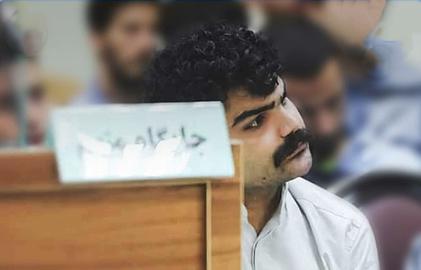Hossein is an inmate at the murderers’ ward at Rajaei Shahr Prison in Karaj near Tehran. Lately, he has been in the business of buying and selling movies and TV programs. Every day, from morning until evening, when prisoners are counted and the doors to the exercise yard are closed, he deals with his clientele out of the windows overlooking the yard. Unlike the inmates who are looking to buy drugs, Hossein’s customers seek out cultural contraband, small memory sticks and flash drives loaded up with their favorite shows and films.
Hossein sells MP3 players as well, small gadgets that can be found for less than two dollars in the passageways of the Tehran Metro — but he sells them through the cell windows for something between $100 and $230. He also sells headphones. If the headphones are not a recognizable brand name, he charges $34, after having bought them for around 34 cents.
Hossein says that, for his clients, TV series like Lost and Prison Break are among the most popular. Next in popularity are foreign action movies. He offers the videos individually or as a package. Dubbed Turkish television shows are also big sellers.
He gets his merchandise through a middleman — who has on occasion been caught red-handed. “When he is caught I can’t meet the demands of my customers,” he says. “At the moment I am in such a situation.”
His customers are very particular about what they want. “Many of them are porn fans, but at this moment I can’t get it for them. As a result, I have temporarily lost part of my income,” Hossein says. He sells each eight-gig porno memory stick for $100 or more, depending on how much the inmate can afford. If the customer wants16-gig or 32-gig memory sticks loaded with pornographic films, he will have to pay between $10 to $35 extra.
Hossein’s trade follows a logic of its own. What determines the price is mostly the content, not the memory size or amount of material on the flash drive. For example, the price for Iranian movies made before the Islamic Revolution of 1979 is close to $70. If the film is longer than normal, then the price goes up by $10 to $20.
Hooshang is one of Hossein’s customers. He wears a certain type of baggy pants and a striped shirt that have come to be known as the “national prison uniform”. He likes movies with highly popular pre-revolutionary stars like Behrouz Vossoughi, Googoosh and Fardin. He says he loves to watch these films over and over. According to him, post-revolutionary Iranian cinema has not made inroads into the prison, except for rare cases, such as The Lizard, a 2004 comedy about a small-time thief who escapes prison and pretends to be a mullah.
Hooshang reports that his memory stick loaded with a collection of songs by Hayedeh and Homeyra, two female singers popular before the revolution, were seized in a recent prison inspection. Currently he is on the lookout for a collection of songs by two male Persian pop singers, Hassan Shamaizadeh and Javad Yasari.
Taking Refuge in Porn
Hooshang, who has been sentenced to life in prison, sings Javad Yasari songs very loudly as he walks through the exercise yard or bathes. At nights he takes refuge in porn. He confesses that, for a short while, during the time he was ward representative, he turned young inmates into “brides” and rented them out to other prisoners. But he claims that he himself has never had sexual relations with other inmates and that porn films are his only recourse to satisfy his sexual needs.
Among the prisons in Iran, Ghezel Hesar is notorious, housing some of the country’s most dangerous criminals — many of whom do not shy away from taking risks. Porn is very popular here. The only cultural products prison officials sanction are the daily newspapers Kayhan and Ettela’at. There is no trace of entertaining newspapers or movies. So the trade in banned movies, especially porn on small flash memories, is booming.
But contraband cultural products in Iranian prisons are not limited to porn, and they are not always used for their intended purposes. For example, each ward receives a single free copy of Kayhan or Ettela’at, which the inmates then fight over. Often the ward representative confiscates the free copy to use as his own tablecloth. Other inmates are not allowed to handle or read the paper so that it will remain pristine clean for its adapted purpose as a tablecloth.
In most prisons, the two above-mentioned newspapers and a few other papers are the only publications allowed. A few prisons, including Evin, enjoy a greater variety of reading material, with prisoners having access to more than a dozen publications. But other prisons, depending on their proximity to Tehran, have far fewer choices.
According to one inmate at Evin Prison, inmates receive a variety of newspapers, even English-language papers such as the Tehran Times and Iran Daily. But prison officials are very careful to prevent reformist publications such as Etemad and Arman from getting into Ward 350, which houses political prisoners.
No English-Language Books
Political prisoners at Evin’s Ward 350 and at Rajaei Shahr are among the largest consumers of contraband cultural products. They vehemently protest against the ban on certain publications and English-language books and do what they can to get around it.
Political prisoners are allowed to subscribe to sanctioned newspapers, but they must pay for it themselves. Among Evin’s political prisoners, the most popular newspapers are Kayhan, Iran and Shargh. This kind of reading material is less in demand in wards housing other kinds of convicts, including armed robbers and drug dealers.
Occasionally, Iran’s Prisons Organization distributes publications it has acquired for free to prisoners, usually because the original subscriber has been moved to another prison or the publications are no longer on the newsstands because they are out of date.
After a political prisoner’s initial interrogation, the prisoner is allowed access to conservative publications or material produced by hardline media, but only after obtaining a written permit from the interrogator. In most prisons, there is no shortage of publications devoted to religion and the Koran, and newspapers like E’etedal or Hemayat, which is published by the Prisons Organization. In prisons in provincial towns, only a single copy of the previous day’s edition of Ettela’at newspaper is made available to a ward.
In the communal spaces of prisons, television is hugely popular. The capacity of these rooms is usually around 20 prisoners, so they are very crowded, especially when a big news story breaks, or when family dramas and comedies are broadcast. But football matches are by far the most-watched broadcasts, particularly Esteghlal and Persepolis games. With the recent success of Iran’s national volleyball team, this sport has also gained in popularity. Prisoners everywhere follow FIFA World Cup matches closely, and many inmates bet on results.
In recent years, however, cheap smartphones and TV sets equipped with USB ports to play recordings from memory sticks have taken over, so that TVs in communal rooms are not quite as popular as they once were.
Prisoners who can afford to buy smartphones now spend most of their time online. And the internet makes access to porn much easier — but of course, smartphones must remain hidden from prison guards.
In many prisons, there are “culture-free” zones. No newspapers or books are allowed into solitary cell blocks such as Wards 2A and 209 at Evin, Evin’s “punishment” wards 240 and 241, and the Revolutionary Guards’ Ward at Rajaei Shahr Prison. Needless to say, these wards are porn-free.
Related articles:
Iran's Ingenious Prisoners: From Moonshine to Electricity
Prison Inspections And Contraband Dealings
Sponge Slippers and Dental Floss: The Delicacies of Iran’s Prisons
visit the accountability section
In this section of Iran Wire, you can contact the officials and launch your campaign for various problems

























comments